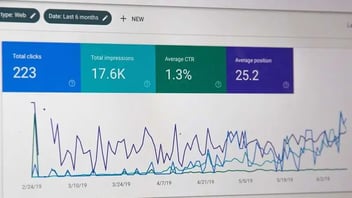10 Proven Link-Building Strategies
Are you struggling to improve your website's search rankings and outrank your competitors? You're not alone.
Many businesses find it challenging to build high-quality backlinks that adhere to Google's strict guidelines and Spam Policies for Google Web Search. But what if there were proven, white-hat link-building strategies that could skyrocket your SEO efforts without risking penalties?

In this article, we'll reveal ten powerful tactics industry experts use to acquire valuable backlinks, boost search engine visibility, and drive targeted traffic to your website. Whether you're a small business owner or an SEO professional, these strategies will help you navigate the complex world of link building and achieve long-term success in the ever-evolving digital landscape.
1. Guest Blogging
Guest blogging is a powerful link-building strategy that involves creating high-quality content for other websites in your industry or niche. By contributing valuable and informative articles to reputable blogs, you can establish yourself as an authority in your field, expose your brand to a new audience, and, most importantly, earn valuable backlinks to your website. These backlinks drive referral traffic and boost your site's credibility and authority in the eyes of search engines, ultimately improving your search rankings.
Finding Relevant Guest Blogging Opportunities
To maximize the impact of your guest blogging efforts, targeting websites relevant to your industry and with a substantial audience is essential. Here are some tips for finding the right guest blogging opportunities:
-
Use Google search operators like "keyword" + "write for us" or "keyword" + "guest post" to find websites that accept guest contributions.
-
Analyze your competitors' backlink profiles to identify websites that have featured their content.
-
Leverage social media platforms like X (Twitter) and LinkedIn to connect with bloggers and influencers in your niche.
-
Attend industry events and conferences to network with potential guest blogging partners.
2. Broken Link Building
Broken link building is an effective link-building strategy that involves identifying broken links on websites relevant to your industry and reaching out to webmasters to suggest a replacement link from your own website. This technique benefits both parties: the webmaster gets to fix a broken link and improve their site's user experience while you gain a valuable backlink to your content.
By leveraging broken link building, you can not only acquire high-quality backlinks but also position yourself as a helpful resource in your niche.
Although broken link building is an older technique, it remains a powerful and effective method for acquiring backlinks.
Finding Broken Links
To embark on a successful broken link-building campaign, you must first identify websites with broken links relevant to your industry. Here's a step-by-step process to help you find these opportunities:
-
Compile a list of relevant websites: Start by creating a list of websites in your industry or niche likely to have resource pages or links to external content.
-
Use a broken link checker tool: Employ a tool like Ahrefs or Semrush to scan the websites on your list for broken links. These tools will help you identify pages with 404 errors or other issues.
-
Analyze the broken links: Once you've found broken links, assess the content of the linking page to determine if it's relevant to your website. Look for opportunities where your content could serve as a suitable replacement.
-
Create replacement content: If you don't have existing content that matches the broken link, consider creating new content that fills the gap and provides value to the linking website's audience.
3. Resource Page Link Building
Resource pages are curated lists of helpful resources on a specific topic, designed to provide value to readers by aggregating the best content in a particular niche. They are valuable for link building because their primary purpose is to link to other websites, making them a natural target for acquiring high-quality, relevant backlinks.
Securing a link on a well-established resource page can drive targeted referral traffic, boost your site's authority, and positively impact your search rankings due to the high PageRank and domain authority these pages often possess.
Strategies for Finding Relevant Resource Pages
To maximize the impact of your resource page link-building efforts, it's crucial to find pages relevant to your niche with high domain authority. Here are some strategies to help you identify the best resource page opportunities:
-
Google searches: Use targeted search operators to find resource pages in your industry. Some examples include:
-
"keyword" + "resources"
-
"keyword" + "useful links"
-
"keyword" + "helpful resources"
-
-
Competitor analysis: Investigate your competitors' backlink profiles using SEO tools to identify resource pages linking to their content. If a page links to your competitor, there's a good chance they'll also be open to linking to your content.
-
Industry blogs and publications: Explore popular blogs and publications in your niche to find resource pages or link roundups that curate the best content regularly.
|
Method |
Advantages |
Disadvantages |
|
Google searches |
Free and easy to perform |
It can be time-consuming to filter through the results |
|
Competitor analysis |
Identifies proven link opportunities |
Requires paid tools like Semrush or Ahrefs |
|
Industry blogs and publications |
High-quality, niche-specific resource pages |
Limited to well-known publications in your industry |
4. Unlinked Brand Mentions
Unlinked brand mentions refer to instances where your brand, product, or service is mentioned on a website without a hyperlink to your site. These mentions indicate that the author or website owner knows your brand and considers it relevant enough to include in their content. The link-building potential lies in the fact that these websites have already shown an interest in your brand, making them more likely to add a link to your site if requested.
By converting unlinked brand mentions into linked ones, you can:
-
Increase your site's referral traffic
-
Boost your brand's online visibility and credibility
-
Improve your search engine rankings with high-quality, relevant backlinks
Unlinked brand mentions are "low-hanging fruits" in link building, as they require less effort to acquire compared to other strategies like guest posting or broken link building.
How to Find Unlinked Brand Mentions
To find unlinked brand mentions, you can use a combination of tools and techniques, such as:
-
Google Alerts: Set up alerts for your brand name, product names, and key personnel to receive notifications whenever they are mentioned online.
-
Social media monitoring tools: Platforms like Hootsuite, Mention, or Brand24 can help you track brand mentions across various social media channels and the web.
-
SEO tools: Offers brand mention monitoring features that help you identify unlinked mentions and analyze their link-building potential.
-
Manual searches: Perform regular Google searches for your brand name and related keywords to find recent mentions that automated tools may not have picked up.
Once you've identified unlinked brand mentions, prioritize them based on the website's relevance, domain authority, and the context in which your brand is mentioned.
5. Competitor Backlink Analysis
Analyzing your competitors' backlinks is crucial in developing a successful link-building strategy. By understanding where your rivals are acquiring their links, you can gain valuable insights into the tactics and sources working well in your niche. This knowledge empowers you to:
-
Identify link gaps
-
Uncover new link prospects
-
Refine your content strategy
-
Benchmark your performance
By leveraging competitor backlink analysis, you can develop a more targeted and efficient link-building strategy that helps you gain a competitive edge in your market.
Tools and Methods for Conducting Competitor Backlink Analysis
To conduct a thorough competitor backlink analysis, you can use a combination of tools and methods, such as:
-
Backlink analysis tools: Such tools offer comprehensive backlink analysis features that allow you to dissect your competitors' backlink profiles, identifying their most valuable link sources and the content that attracts the most links.
-
Manual research: Explore your competitors' websites to identify their most linked-to pages and the types of content that seem to resonate with their audience.
-
Industry research: Stay up-to-date with the latest trends, publications, and influencers in your niche to discover potential link opportunities your competitors may be pursuing.
6. Infographic Link Building
Infographics have emerged as one of the most powerful tools for attracting backlinks in the content marketing landscape. These visually compelling and easily digestible pieces of content are highly shareable and can quickly capture the attention of a wide audience. The effectiveness of infographics for link-building lies in their ability to:
-
Simplify complex information: Infographics break down complex topics into easily understandable visual representations, making them appealing to a broad range of viewers.
-
Enhance shareability: The visual nature of infographics makes them highly shareable across various platforms, including social media, blogs, and websites, increasing their potential for attracting backlinks.
-
Demonstrate expertise: Well-designed infographics showcase your brand's expertise and thought leadership in your industry, encouraging others to link to your content as a valuable resource.
-
Improve content diversity: Infographics add variety to your content mix, providing a refreshing alternative to traditional blog posts and articles, which can help attract links from a wider range of sources.
Strategy for Promoting Infographics and Securing Backlinks
Once you've created a high-quality infographic, promoting it effectively to maximize its link-building potential is essential. Here's a strategy for promoting your infographic and securing backlinks:
-
Publish on your website
-
Share on social media
-
Reach out to industry influencers
-
Submit to infographic directories
-
Conduct targeted outreach
-
Leverage paid promotion
7. Digital PR
Digital PR is a strategic approach to building a brand's online presence and reputation through creating and distributing newsworthy content, developing relationships with key influencers and journalists, and the management of online brand mentions. In the context of link building, digital PR plays a crucial role by:
-
Earning high-quality backlinks
-
Increasing brand visibility
-
Establishing thought leadership
-
Fostering relationships with influencers
According to the bizZzdev agency's experience, digital PR is the most successful technique for businesses looking to build high-quality backlinks and improve their online visibility. By leveraging the power of digital PR, companies can earn authoritative backlinks, drive referral traffic, and establish their brand as a leader in their industry.
Examples of Successful Digital PR Campaigns
To illustrate the power of digital PR for link building, let's take a look at some successful campaigns that generated significant backlinks:
-
Oreo's "Oreo Thins Protection Program" (2022): A humorous campaign promoting Oreo Thins cookies, generating coverage and backlinks from Adweek, Marketing Dive, and The Drum.
-
Dove's "Reverse Selfie" (2021): A powerful video highlighting the pressure young girls face on social media, generating coverage and backlinks from CNN, The Guardian, and Teen Vogue.
-
LEGO's "Rebuild the World" (2021): An imaginative campaign encouraging children's creativity, generating coverage and backlinks from Forbes, Fast Company, and The Drum.
-
Patagonia's "Earth Day 2023": A campaign promoting sustainability and environmental responsibility, generating coverage and backlinks from The New York Times, Business Insider, and Sustainable Brands.
-
Wendy's "Rick and Morty" (2022): A partnership with the popular animated series, generating buzz on social media and coverage from AdAge, IGN, and Comicbook.com.
These recent examples showcase how brands across various industries use creative, timely, and socially relevant digital PR campaigns to generate media coverage, engagement, and high-quality backlinks.
8. Skyscraper Technique
The skyscraper technique is a link-building strategy that involves identifying popular, high-performing content in your niche and creating a superior version of that content to attract backlinks. The name "skyscraper" comes from building a piece of content that stands taller than the rest, just like a skyscraper stands out in a city skyline. The technique works by:
-
Finding successful content: Identify content in your niche that has already performed well in attracting backlinks and social shares.
-
Creating a superior version: Produce a piece of content that surpasses the original in terms of quality, depth, and value, making it the new go-to resource on the topic.
-
Promoting your content: Reach out to websites that link to the original content and other relevant sites to promote your new and improved version and secure backlinks.
By leveraging the success of existing content and creating a superior alternative, the skyscraper technique can help you attract high-quality backlinks and establish your website as a valuable resource in your industry.
The Process of Finding Content to "Skyscrape"
To find content that is worth "skyscraping," follow these steps:
-
Identify relevant keywords
-
Search for top-performing content
-
Analyze the content
-
Assess the backlink potential
-
Choose the best candidate
By following this process, you can identify content ripe for the skyscraper technique and maximize your chances of creating a successful piece of content that attracts backlinks.
9. Testimonial Link Building
Testimonial link-building is a strategy that leverages the power of positive reviews and endorsements to secure valuable backlinks for your website. By providing testimonials for products, services, or companies you genuinely support, you can often earn a backlink from their website, as many businesses feature customer testimonials on dedicated pages or alongside their offerings. The power of testimonials for link-building lies in the following:
-
Establishing trust and credibility: Testimonials serve as social proof, demonstrating that others trust and value the product or service you endorse, which can make your website appear more credible by association.
-
Building relationships: By providing a testimonial, you are building a relationship with the company or website you endorse, which can lead to future collaboration opportunities and additional backlinks.
-
Attracting targeted referral traffic: If your testimonial is featured on a website relevant to your niche, it can drive targeted referral traffic from people interested in the product or service you endorsed.
-
Improving brand visibility: Having your brand name and website URL featured alongside a positive testimonial can increase your online visibility and brand awareness, even if readers don't click through to your site.
By incorporating testimonial link building into your overall strategy, you can diversify your backlink profile, build valuable relationships, and drive targeted traffic to your website.
How to Identify Opportunities to Provide Testimonials
To find opportunities to provide testimonials and earn backlinks, consider the following strategies:
-
Reflect on products and services you use: Make a list of the products, services, and tools you genuinely use and appreciate in your business or personal life. These could be software tools, courses, consulting services, or physical products.
-
Look for "Testimonials" or "Reviews" pages: Visit the websites of the companies or products you've identified and look for pages that feature customer testimonials or reviews. If they have such a page, there's a good chance they'd be open to receiving your testimonial.
-
Reach out to companies directly: If a company doesn't have a visible testimonials page, consider contacting them directly via email or social media to express your appreciation for their product or service and offer a testimonial.
-
Monitor brand mentions: Use tools like Google Alerts or Mention to monitor online mentions of your brand. If someone positively mentions your business, reach out to thank them and offer to provide a testimonial for their website in return.
-
Participate in case studies: If a company you work with offers to feature your business in a case study, accept the opportunity and provide a detailed, positive testimonial they can include in the case study and on their website.
By proactively seeking out opportunities to provide testimonials, you can build a consistent stream of high-quality backlinks to your website.
10. Community Engagement
Engaging in online communities and forums related to your niche is a powerful way to build relationships, establish expertise, and earn valuable backlinks. By actively participating in discussions, sharing your insights, and providing helpful resources, you can position yourself as a trusted authority in your field and attract the attention of potential link partners.
To maximize the relationship-building potential of community engagement, consider the following:
-
Choose relevant communities: Focus on communities and forums directly related to your niche or target audience to ensure you connect with the right people.
-
Provide value: Share your knowledge, experiences, and resources generously, focusing on helping others rather than self-promotion.
-
Engage consistently: Participate in discussions regularly to maintain visibility and build stronger connections with other members.
-
Be authentic: Be genuine in your interactions and focus on building real relationships rather than just seeking out backlink opportunities.
When earning backlinks through community engagement, it's essential to prioritize relevance and value. Only share links that are genuinely useful and relevant to the discussion, and avoid spamming or over-promoting your content. By providing value and building authentic relationships, you can naturally attract high-quality backlinks that drive traffic and boost your search rankings.
Conclusion
In this guide, we've covered ten proven link-building strategies to boost your SEO efforts in 2024. From guest blogging and broken link building to digital PR and community engagement, these tactics can help you acquire high-quality backlinks and establish your website as an authority in your niche.
As you implement these strategies, prioritize relevance, quality, diversification, and authenticity. Consistency and patience are essential, as building a solid backlink profile takes time and effort.
Always adhere to Google's guidelines and Spam Policies for Google Web Search to avoid penalties. Focus on creating valuable content and building genuine relationships rather than engaging in spammy tactics.
This content is also available in:
- Deutsch: 10 Bewährte Linkbuilding-Strategien
- Español: 10 Estrategias Comprobadas para la Construcción de Enlaces
- Français: 10 Stratégies de Création de Liens éprouvées
- Italiano: 10 strategie collaudate per la creazione di link
- Română: 10 strategii de Link-Building dovedite
- 简体中文: 10 个经过验证的链接建设策略

Opinions expressed in this article are those of the guest author. Aspiration Marketing neither confirms nor disputes any of the conclusions presented.








Leave a Comment